NASA approves Mars search for its missing atmosphere (images)


NASA gave the go-ahead on a 2013 launch of a spacecraft that will travel to Mars to help determine what happened to its atomosphere. The project is called the Mars Atmosphere and Volatile Evolution (MAVEN).
Mars once had a dense atmosphere that supported water in the form of rivers, lakes and oceans. But as a result of climate change, most of the atmosphere vanished and along with it, almost all the water. MAVEN is expected to find clues to explain why this happened.
For more about MAVEN, check out Larry Dignan's blog in Smartplanet.
Credit: NASA
The plan is for the MAVEN spacecraft to arrive at Mars in the fall of 2014 and take scientific measurements for a full Earth year.
""A better understanding of the upper atmosphere and the loss of volatile compounds like carbon dioxide, nitrogen dioxide and water to space is required to plug a major hole in our understanding of Mars," said Bruce Jakosky, principal investigator on the mission, from the University of Colorado at Boulder's Laboratory for Atmospheric and Space Physics.
Mars explorations have shown that the riverbeds are now empty. Why did the water disappear?
Ice still forms on Mars in the polar regions as shown in this photo from the Hubble space telescope.
Another empty Martian river channel.
Rivers perhaps?
Looks like the India Ocean.
A possible delta region.
The Mars Reconnaissance Orbiter has been studying the Martian atmosphere for four years.
Scientists believe that loss of the Martian magnetic field may be a major cause of the atmospheric loss.
The MAVEN spacecraft is being built by Lockheed-Martin.